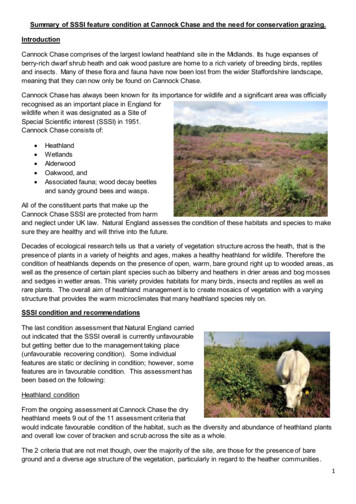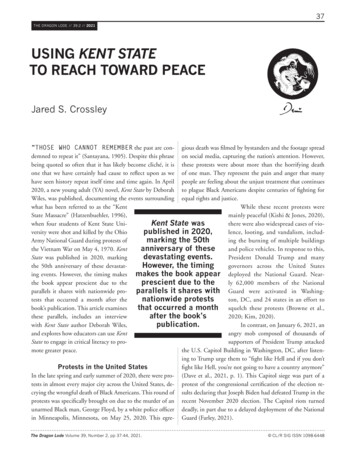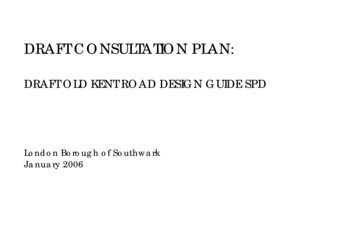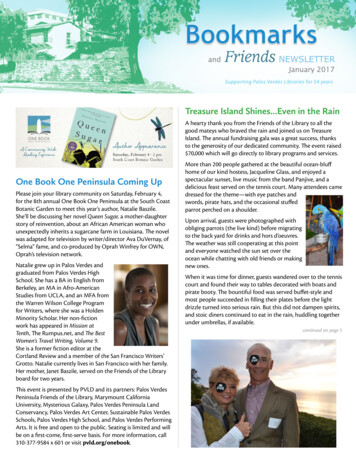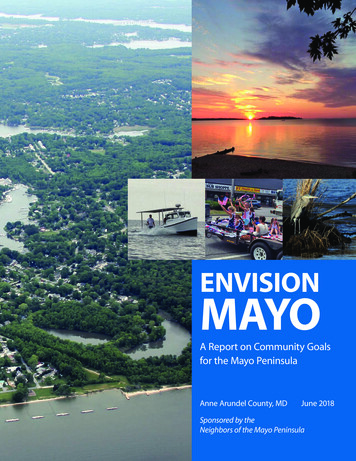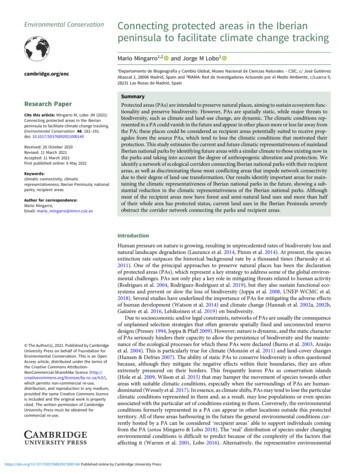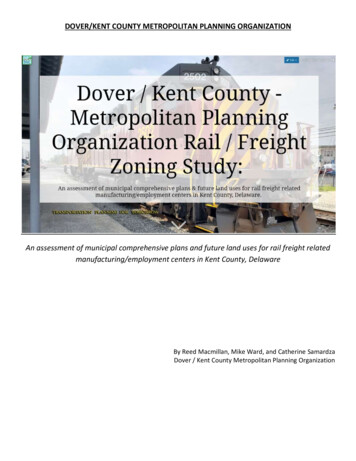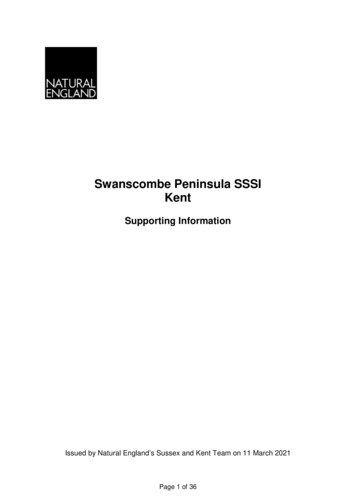
Transcription
Swanscombe Peninsula SSSIKentSupporting InformationIssued by Natural England’s Sussex and Kent Team on 11 March 2021Page 1 of 36
Contact points and further informationThis supplement is issued on request by Natural England’s Kent and Sussex Team and is intendedto be read in conjunction with the notification document for owners, occupiers and other notifiedparties.During the current coronavirus situation, Natural England staff are working remotely, and a limitednumber of our offices are open. Please send any correspondence relating to this notification byemail or contact us by phone using the information below. Alternatively, you can send a responseonline using the link below.Your contact point for enquiries relating to this notification is Neil Fuller.Telephone number: 07900 227219E-mail: thamesestuary@naturalengland.org.ukOnline: combe-peninsulaPage 2 of 36
ContentsSummary1.Information used to support the selection of Swanscombe Peninsula SSSI.2.Explanation of how Swanscombe Peninsula meets the SSSI selection guidelines.3.Assessment of the current condition of Swanscombe Peninsula SSSI.4.Selection of ‘operations requiring Natural England’s consent’.5.Photographs.Annex 1.Annex 2.Annex 3.Annex 4.Habitat Map.Map showing location of comparison sites listed in Table 3.Map showing location of comparison sites listed in Table 5.List of invertebrate species with Conservation Status recorded at SwanscombePeninsula SSSI.Page 3 of 36
SummarySwanscombe Peninsula SSSI is notified under section 28C of the Wildlife and Countryside Act1981. The site is a complex of open mosaic habitats on previously developed land and traditionalestuarine habitats located near and within the River Thames, Kent. Habitats include chalk pits,free-draining grassland, scrub, wetlands, grazing marsh, mudflats and saltmarsh (see habitat mapat Annex 1). Swanscombe Peninsula SSSI is of special interest for the following nationallyimportant features: Quaternary geology at Bakers Hole, a key Pleistocene site with a complex sequence ofperiglacial and temperate climate deposits, and Middle Palaeolithic archaeology; populations of the plants divided sedge Carex divisa, yellow vetchling Lathyrus aphaca,slender hare’s-ear Bupleurum tenuissimum, Bithynian vetch Vicia bithynica and round-leavedwintergreen Pyrola rotundifolia subsp. maritima; assemblages of invertebrates chiefly associated with bare sand and chalk; open short swards;open water on disturbed mineral sediments; and saltmarsh and transitional brackish marsh;and two diverse assemblages of breeding birds: one associated with lowland open waters and theirmargins, lowland fen and lowland damp grassland; the other with lowland scrub.Page 4 of 36
1.Information used to support the selection of SwanscombePeninsula SSSIFeatureGeneralGeologyVascularplantsData sourceGuidelines for the Selection ofBiological SSSIs. Part 1:Rationale, OperationalApproach and Criteria for SiteSelection. art1-Rationale2013.pdf.GCR Block Site ReportNorthfleet (Ebbsfleet valley):Baker’s Hole Complex.Quaternary of the Thames.JNCC, Peterborough.An Introduction to theGeological ConservationReview. GeologicalConservation Review Series.JNCC, e-9e70-4216-924d90c3390b0715/GCR-Intro.pdf.Baker's Hole SSSI/SAM FieldSurvey Report.University of Southampton.AuthorBainbridge, I.,Brown, A.,Burnett, N.,Corbett, P.,Cork, C., Ferris,R., Howe, M.,Maddock, A. &Pritchard, S.(eds).Date Content2013 General principlesand guidance for theselection of SSSIs.Bridgland, D.R.1994 Detailed descriptionand justification forinclusion of BakersHole in the GeologicalConservation Review.1996 Background to theGeologicalConservation Review.Project 6478, Baker's Hole SMand SSSI, Strategic ConditionField Survey Final Report:Current Condition and FutureManagementrecommendations.University of Southampton.Baker's Hole SM and SSSI,Area B: Report on Assessmentof the Temperate Bed underHAR Programme.University of Southampton.Wenban-Smith,F.Baker’s Hole SM and SSSIField Survey (Area B) closurereport: Temperate Bedvulnerability, managementpriorities and collation ofspecialist analyses.University of Southampton.British Red Data Books:Vascular Plants. Society forNature Conservation, Lincoln.Wenban-Smith,F.Ellis, N.V. (ed.),Bowen, D.Q.,Campbell, S.,Knill, J.L.,McKirdy, A.P.,Prosser, C.D.,Vincent, M.A. &Wilson, R.C.L.Wenban-Smith,F.Wenban-Smith,F.Perring, F.H.and Farrell, L.Page 5 of 362012 Field survey andrecommendations forfuture management ofBakers Hole SSSI.2015 Field survey,condition assessmentandrecommendations forfuture management ofBakers Hole SSSI.2016 Field survey,assessment ofsamples andrecommendations forfuture management ofBakers Hole SSSI.2018 Field survey,assessment ofsamples andrecommendations forfuture management ofBakers Hole SSSI.1977 Status definitions forvascular plants.
FeatureData sourceBritish Red Data Books: 1.Vascular Plants, 2nd ed. RoyalSociety for NatureConservation, Lincoln.The Vascular Plant Red DataList for Great Britain.Species Status 7: 1-116.JNCC, arPlant-WEB2005.pdf.England Rare and ScarceTaxa, a report for NE.Botanical Society of Britainand Ireland.A Vascular Plant Red Data Listfor England. Botanical Societyof Britain and Ireland, London.https://bsbi.org/wpcontent/uploads/dlm uploads/England Red List 1.pdf.Biological Records Centres.JNCC Taxon DesignationsSpreadsheet, accessedNovember 4366-acdf8941fd33850bThe BSBI DistributionDatabase and rare bsbi.org/rare-plantregistersThe London ResortPreliminary EnvironmentalInformation Report. Appendix12.1 Ecology Baseline rPerring, F.H.and Farrell, L.Date Content1983 Status definitions forvascular plants.Cheffings, C.M.& Farrell, L.(Eds), Dines,T.D., Jones,R.A., Leach,S.J., McKean,D.R., Pearman,D.A., Preston,C.D., Rumsey,F.J., Taylor, I.Stroh, P.2005 Status definitions forthreatened plants.Stroh, P.A.,Leach, S.J.,August, T. A.,Walker, K.J.,Pearman, D.A.,Rumsey, F.J.,Harrower, C.A.,Fay, M.F.,Martin, J.P.,Pankhurst, T.,Preston, C.D. &Taylor, I.Kent & MedwayBiologicalRecords Centre,GreenspaceInformation forGreater Londonand EssexWildlife Trust.JNCC2014 IUCN assessment ofvascular plants inEngland.BotanicalSociety ofBritain andIreland2020 Distribution of plantsby Area of Searchand details of therarest species in thecounty.TheEnvironmentalDimensionPartnership Ltd2020 Report on baselineecology andimportant ecologicalfeatures withinSwanscombePeninsula.Page 6 of 362013 Status definitions forthreatened plants.1987 Records withtoabundance of Pyrola2020 rotundifolia subsp.maritima and Pyrolarotundifolia subsp.unspecified within theGreater ThamesEstuary NCA.2020 GB and Englandconservation status.
FeatureInvertebratesData sourceAuthorDate ContentAnnex EDP 1 - habitat descriptions and illustrative photographs.Annex EDP 12 – desk study and phase 1 habitat survey with 2012 habitatdescriptions for key plants. Chris Blandford Associates.Annex EDP 13 – 2012 survey records for key plants. Chris Blandford Associates.Annex EDP 14 - phase 1 habitat and botanical survey with 2015 survey recordsfor key plants. Chris Blandford Associates.Plan EDP 5 - rare plant species population plan with 2020 survey records for keyplants. The Environmental Dimension Partnership Ltd.Guidelines for the Selection of Taylor, I.,2021 Selection guidanceBiological SSSIs. Part 2:Leach, S. J.,for vascular plants.Detailed Guidelines forMartin, J. P.,Habitats and Species Groups.Jones, R. A.,Chapter 11 Vascular Plants.Woodman, J.JNCC, Peterborough.and ular-plants-2021.pdf.Aquatic invertebrate surveys of Leeming, D.J &2005 Comparison of sitethe Inner Thames MarshesEngland, J.with others in theSSSI 1998-2001.NCA. Tables 4 and 99 Aquaticinvertebrate surveys of theInner Thames Marshes SSSI1998-2001Invertebrate Survey andHarvey, P.R.2005 Comparison of siteAssessment for West Thurrockwith others in theLagoons.NCA. Tables 3 and 5.Invertebrate Survey andHarvey, P.R.2005 Comparison of siteAssessment for Corys Wharfe,with others in thePurfleet.NCA. Table 3.Site A, East Tilbury SaltingsHarvey, P.R.2006 Comparison of siteand Silt Lagoons, S. Essex.with others in theInvertebrate Survey andNCA. Table 5.Assessment.Isle of Grain, Kent, NationalColin Plant2010 Comparison of siteGrid Property Holdings,Associates (UK)with others in theInvertebrate Survey Report NoNCA. Tables 3 and 5.BS/2506/10.Grain 2010 AquaticKirby, P.2010 Comparison of siteInvertebrate Survey. Report towith others in theRPS.NCA. Tables 4 and 5.Land at Vopack Terminal,Aspect Ecology 2010 Comparison of siteOliver Road, West Thurrock,with others in theEssex. Revised MitigationNCA. Table 3.Proposals Based on ISISAnalysis of InvertebrateInterest.Thurrock Thameside NatureHarvey, P.R.2014 Comparison of sitePark Invertebrate Surveywith others in theReport.NCA. Table 3.Page 7 of 36
FeatureData sourceIsle of Grain, Kent, NationalGrid Property Holdings,Invertebrate Survey Report NoBS/2879/14.W M Morrison SupermarketsPlc. Proposed Non Food RetailWarehouse, Off NorthwickRoad, Canvey Island, Essex.Ecological Mitigation Plan –Results of EcologicalMonitoringInvertebrate Survey atFoulness Island.AuthorColin PlantAssociates (UK)Date Content2014 Comparison of sitewith others in theNCA. Tables 3 and 5.Hadleigh Park InvertebrateAssemblage Monitoring.Harvey, P.R.Pantheon: A New Resource forInvertebrate Survey Standardsand 1/InPractice98 Dec2017.pdfGuidelines for the Selection ofBiological SSSIs Part 2:Detailed Guidelines forHabitats and Species Groups.Chapter 20 Terrestrial andFreshwater Invertebrates.JNCC, ertebrates2019.pdf.Oikos Marine & South SideDevelopment ProtectedSpecies Report – Draft.Stanhope Industrial ParkInvertebrate SurveyHeaver, D.,Webb, J., Roy,D., Dean, H.,Harvey, M.,Macadam, C.and Curson, J.Curson J.,2019 SSSI selectionHowe, M, Webb,guidance forJ., Heaver D. &invertebrates.Tonhasca, A.Penny Anderson 2014 Comparison of siteAssociates Ltdwith others in theNCA. Table 3.Harvey, P.R.2015 Comparison of sitewith others in theNCA. Table 5.2015 Comparison of sitewith others in theNCA. Table 5.2017 Description of howPantheon works andwhat it does.WatermanInfrastructure &Environment LtdSmith, M.2020 Comparison of sitewith others in theNCA. Table 3.2020 Comparison of sitewith others in theNCA. Table 3.The London ResortThe2020 Report on baselinePreliminary EnvironmentalEnvironmentalecology andInformation Report. AppendixDimensionimportant ecological12.1 Ecology Baseline Report. Partnership Ltd.features insula.dices/.Annex EDP 27 - Survey records for terrestrial invertebrates 2012. ChrisBlandford Associates.Annex EDP 28 - Survey records for terrestrial invertebrates 2015. EdwardsEcological Services Limited.Annex EDP 29 - Survey records for spiders and related groups 2012. ChrisBlandford Associates.Page 8 of 36
FeatureData sourceAuthorDate ContentAnnex EDP 30 - Survey records for aquatic macroinvertebrates withinwaterbodies and wetlands 2015. Aquatic Survey & Environmental Data Analyses(Aseda).Annex EDP 31 - Survey records for aquatic macroinvertebrates within selectedwaterbodies 2015. Aquatic Survey & Environmental Data Analyses (Aseda).BirdsThe London ResortDevelopment Consent OrderEnvironmental StatementVolume 2: Appendix 12.1Ecology Baseline Report,Annex EDP entalDimensionPartnership Ltd.2020 2020 invertebratesurvey report.Pantheon analysis ofinvertebrate survey records.NERR in prep.Natural England2020 Pantheon analysis of2012 and 2015survey data.Kent Ornithological gicalSociety2010 Breeding seasontorecords for bird2020 species withinSwanscombePeninsula.Biological Records Centre.Unpublished.Kent & MedwayBiologicalRecords Centre2010 Breeding seasontorecords for bird2020 species withinSwanscombePeninsula.BTO Heronries onriescensus.BTO BirdTrack data.British Trust forOrnithology2011 Numbers of breedingtopairs of heron species2020 in the UK.British Trust forOrnithology2015 Breeding seasontorecords for bird2020 species withinSwanscombePeninsula.Guidelines for the Selection ofBiological SSSIs. Part 2:Detailed Guidelines forHabitats and Species Groups.Chapter 17: Birds. 7-Birds2020revised-A.pdfDrewitt, A. L.,Whitehead, S.and Cohen, S.2020 SSSI selectionguidance for birds.Page 9 of 36
FeatureData sourceThe London ResortPreliminary EnvironmentalInformation Report. Appendix12.1 Ecology Baseline rTheEnvironmentalDimensionPartnership LtdDate Content2020 Report on baselineecology andimportant ecologicalfeatures withinSwanscombePeninsula.Annex EDP 17 - breeding bird survey 2012. Chris Blandford Associates.Annex EDP 18 – breeding bird survey 2015. Corylus Ecology.Annex EDP 4 - breeding and passage bird surveys 2020. The EnvironmentalDimension Partnership Ltd.Plans EDP 8, 9 & 10 – breeding bird survey mapped data for April, May and June2020. The Environmental Dimension Partnership Ltd.2.Explanation of how Swanscombe Peninsula meets the SSSIselection guidelinesThis section explains how the information listed in Section 1 has informed the decision to notify theSSSI, according to the Guidelines for the selection of Biological SSSIs. Part 1: Rationale,Operational Approach and Criteria for Site Selection (Bainbridge et al. 2013) and Part 2: DetailedGuidelines for Habitats and Species Groups, hereafter referred to as ‘the Guidelines’ andaccording to the selection guidelines listed in ‘An Introduction to the Geological ConservationReview’ (Ellis et al. 1996).2.1GeologyThe special geological interests at Bakers Hole were selected for inclusion in the GeologicalConservation Review (GCR) of Great Britain and are described under ‘Northfleet (Ebbsfleet valley):Baker’s Hole Complex’. The GCR systematically assesses sites to identify key localities that aidthe interpretation of the geological evolution of Great Britain. Each GCR site demonstrates aunique and/or representative feature of this geological evolution, and the relationship between sitesis particularly important in building up a picture of landscape evolution and biological andenvironmental change over time.All SSSIs with a geological interest have been assessed through the GCR process and sitesdescribed in the Review are eligible for selection on the basis of at least one of the followingcategories:1. Sites of importance to the international community of Earth scientists.2. Sites that are scientifically important because they contain exceptional features.3. Sites that are nationally important because they are representative of an Earth sciencefeature, event or process that is fundamental to Britain’s Earth history.Bakers Hole has been selected under category 3. It is a key Pleistocene site exposing a complexsequence of periglacial and temperate climate deposits associated with the Ebbsfleet Valley. Thedeposits have yielded palaeoenvironmental information including fossils of mammals, ostracodsand molluscs in addition to Levallois artefacts from the Middle Palaeolithic. The site records thepenultimate interglacial known as Marine Isotope Stage (MIS) 7. It is thought that the threetemperate episodes from MIS 7 are all represented at Bakers Hole.2.2Vascular plantsData from a range of surveys and sources has been collated to determine the qualifying plantspecies present at Swanscombe Peninsula SSSI. The surveys/data are as follows: Surveys undertaken in 2012, 2015 and 2020 as part of the Preliminary EnvironmentalReport (PIER) for the London Resort. Botanical Society of Britain and Ireland (BSBI) records.Page 10 of 36
Verified Record Centre data covering the Greater Thames Estuary NCA (1987-2020). Kent Botanical Recording Group records.2.2.1Nationally Scarce and Vulnerable SpeciesThe Guidelines (Chapter 11, section 4.1.1, p8) state that:‘Restricted Range (GB or country-level Rare/Scarce 1) threatened taxa qualifying as CR, EN orVU under IUCN criteria A, B, C and/or D, IUCN (2012a). All localities with sustainablepopulations should be considered for selection.’Populations of four vascular plant species listed as Nationally Scarce in Great Britain (and in onecase in England) in the most recent national review (Stroh 2013) have been recorded atSwanscombe Peninsula SSSI. The upper threshold for Scarce status is 100 hectads in GreatBritain (Perring & Farrell 1977, 1983). They are also assessed as Vulnerable (VU 2) in Great Britain(Cheffings & Farrell 2005) and in some cases England (Stroh et al 2014) under IUCN criterion A2c.The species are: Divided sedge Carex divisa, recorded post 1987 from 93 hectads – Nationally Scare (GB),IUCN Vulnerable (GB), Native. Also listed as a ‘species of principal importance in England’under Section 41 of the Natural Environment and Rural Communities Act (2006). Yellow vetchling Lathyrus aphaca, recorded post 1987 from 62 hectads – Nationally Scarce(GB), IUCN Vulnerable (England and GB), Native or Alien. Slender hare’s-ear Bupleurum tenuissimum recorded post 1987 from 69 hectads –Nationally Scarce (GB), IUCN Vulnerable (England and GB), Native. Also listed as a‘species of principal importance in England’ under Section 41 of the Natural Environmentand Rural Communities Act (2006). Bithynian vetch Vicia bithynica recorded post 1987 from 35 hectads – Nationally Scarce(England and GB), IUCN Vulnerable (England and GB), Native.In addition to the selection criteria stated above, the Guidelines (Chapter 11, section 4, p7) providethe following guidance on sustainable populations:‘Sustainability is hard to define, and in many cases population size will have to serve as a‘proxy’ measure of its sustainability – the assumption being that a large population is likely tobe more ‘sustainable’ than a small one. Evidence of a population being long-established,whether through its long-recorded history or (in the case of long-lived perennial taxa) thepresence of old plants along with cohorts of younger plants of different ages, will also behelpful in ascertaining its likely sustainability. Further supporting evidence could includeobservations of plants flowering and setting seed, the presence of seedlings and anunderstanding of seed bank viability. Evidence of long continuity of suitable habitat, andappropriate habitat management, may also be important.’An assessment of the sustainability of populations of the above four species within SwanscombePeninsula SSSI is summarised in Table 1. The assessments take account of population size,continuity, mechanism of propagation, current location and supporting habitat. All are considered tobe native to Kent.1 At the GB level Nationally Rare (NR) species are those occurring in 1 to 15 hectads. Nationally Scarce (NS)species are those occurring in 16 to 100 hectads.2 Vulnerable (VU) - IUCN Red List category where the best available evidence indicates that a speciesmeets any of the criteria A to E and is therefore considered to be facing a high risk of extinction in the wild.Page 11 of 36
Table 1: Assessment of population sustainability.SpeciesPopulation sustainability assessmentDivided sedge Carex divisaSmall to medium population mainly on Botany Marsh but also recordedin Black Duck Marsh in 2016. This species has been consistentlyrecorded at Swanscombe Peninsula SSSI since 1992 (BSBI database)and specifically in relict grazing marsh between 1995 (KMBRC) and2020 (London Resort PEIR Annex EDP 1). Due to its perennial lifecycle, continued presence in well-established coastal grassland, someof which is under active management as part of a Local Wildlife Site,the population at Swanscombe Peninsula SSSI is considered to besustainable.Yellow vetchling Lathyrus aphacaLarge population estimated as thousands in 2015 mainly on grasslandareas of Broadness and the sea wall corridor. Since then newpopulations have been found in the north east of the site and BotanyMarsh. This species has been consistently recorded at SwanscombePeninsula SSSI since 1991 (KMBRC, Kent Rare Plant Register, BSBIdatabase). Populations in the Swanscombe area are regarded as native(BSBI database accessed Jan 2021). Due to its long establishedpresence, habitat requirements and capacity to spread by seed thepopulation at Swanscombe Peninsula SSSI is considered to besustainable.Slender hare’s-ear BupleurumtenuissimumSmall – medium populations ( 200 plants) were recorded in 2015 intrackways between Botany Marsh West and Broadness. Slender hare’sear has been consistently recorded at Swanscombe Peninsula SSSIsince 1995 (KMBRC, BSBI database). This species is very hard toidentify when not in fruit (late summer and autumn). No records fromthe most recent survey in 2020 may be due to the timing of the survey.Experience from other Thames Estuary sites indicates that populationsare persistent despite annual fluctuations and that this species readilytakes advantage of suitable conditions created by targeted soildisturbance. On this basis, the population at Swanscombe PeninsulaSSSI is considered to be sustainable.Bithynian vetch Vicia bithynicaLarge population estimated as hundreds to thousands mainly ongrassland areas of Broadness and the sea wall corridor. This specieshas been consistently recorded at Swanscombe Peninsula SSSI since2012 (London Resort PEIR Annex EDP 13). Although it has an annuallife cycle and will be subject to population fluctuations, experience onother sites within the Thames Estuary indicates that it will readily takeadvantage of suitable conditions. On this basis, the population atSwanscombe Peninsula SSSI is considered to be sustainable.2.2.2Nationally Scarce SpeciesThe Guidelines (Chapter 11, section 4.4, p9) state that:‘A locality with a sustainable population of one GB or country-level Scarce taxon should beconsidered for selection if any of the following applies:4.4.1 In the case of a GB Scarce taxon, it is one of the three largest populations in GB.Page 12 of 36
4.4.2 In the case of either a GB or country-level Scarce taxon, it is the largest (or only)sustainable population within an AoS 3.’Two National Character Areas (NCAs 4) define the Area of Search (AoS) for SwanscombePeninsular SSSI. The majority of the SSSI falls within the Greater Thames Estuary NCA. Theremainder, which includes Bamber pit, Craylands pit, Sports Field East Quarry, Bakers Hole and astrip of land between the Channel Tunnel Rail Link and Stanhope Road, lies within the North KentPlain NCA.Within GB the Nationally Scarce round-leaved wintergreen Pyrola rotundifolia subsp. maritima hasbeen recorded in 23 hectads (Stroh 2013). There are eleven records for this subspecies within theGreater Thames Estuary and North Kent Plain NCAs. Table 2 compares these records andconfirms that Swanscombe Peninsula SSSI supports the largest known population within the Areaof Search.Table 2. Records of round-leaved wintergreen subsp. maritima within the Greater ThamesEstuary and North Kent Plain NCAs.SiteSwanscombePeninsula SSSIDate19911991-991999201420152020West KentOtterham QuayStone/Atlas Stone pitHectad TQ571970-861991199919911992RecordsKMBRC 5 - location confirmed. No population details.Kent Rare Plant Register - location confirmed. No populationdetails.BSBI database – location confirmed. No population details.BSBI database & KMBRC – several loosely associatedgroups of 16, 18 and 10 flowering spikes.BSBI database & KMBRC – flowering and flowered plantsspread over several metres.London Resort Holdings Ltd survey – single populationcovering 3 square metres.BSBI database – location confirmed. No population details.KMBRC - location confirmed. No population details.BSBI - location confirmed. No population details.KMBRC - location confirmed. No population details.GIGL 6 - location confirmed. No population details.Taking account of the population size, location, supporting habitat and that this subspecies isperennial the population is considered to be sustainable. It is therefore selected under section4.4.2 of the Guidelines, as the largest sustainable population of a Nationally Scarce species withinthe Area of Search.2.3InvertebratesSpecies data from surveys carried out in 2012 (Chris Blandford Associates) and 2015 (EdwardsEcological Services Limited and Aquatic Survey & Environmental Data Analyses) has beenimported into Pantheon. Further surveys commissioned by London Resort Company HoldingsLimited were carried out in 2020. Although the detailed data from the 2020 surveys has not beenmade available to Natural England, a summary report and Pantheon analysis is provided within theTo provide a good representation of the range and diversity of “best example‟ sites across Great Britain,SSSI selection has been carried out since 1979 on a basis which subdivides Britain into a number ofgeographical units. These are called “Areas of Search‟ (AoS)‟. In England AoS are defined as NationalCharacter Areas (NCAs).4National Character Areas (NCAs) divide England into 159 natural areas, each defined by a uniquecombination of landscape, biodiversity, geodiversity and economic and cultural activity. For more informationon NCA’s see aking.5 Kent and Medway Biological Record Centre.6 Greenspace Information for Greater London.3Page 13 of 36
London Resort Development Consent Order Environmental Statement. The results of the 2020surveys are consistent with those from 2012 and 2015.Pantheon is a database tool developed by Natural England and the Centre for Ecology &Hydrology which analyses survey data for invertebrates. Pantheon determines associated habitats,assemblage types and conservation status. This information can be used to determine site quality(Heaver et al. 2017). Quality has primarily been assessed on the basis of species numbers,diversity and rarity. Quality can also be summarised using the species quality index 7 (SQI) for thesite.The Guidelines (Chapter 20, section 3, p7) state that:‘Ideally, site selection for species and assemblages should be based on stable populationsthat have been resident for at least three years. However, since many threatened species areexperiencing severe declines this approach should be used as a guideline only and there maybe ample justification for the selection of species and assemblages in unfavourable condition’.The assessments in sections 2.3.1 to 2.3.4 are based on two sets of survey data which are threeyears apart.There are four principal invertebrate assemblages present at Swanscombe Peninsula SSSI. Twoare present within brownfield habitat and the remaining two within wetland and saltmarsh.2.3.1Brownfield habitat invertebrate assemblages.The Guidelines (Chapter 20, section 3.10, p9) state that:‘All sites that support assemblages which are of either national or international importanceshould be selected.Sites with assemblages which, because of the nature of the supporting habitat, are scarceand/or poorly represented within the biological SSSI series may all be selected within the AoS.The species within the assemblages may be few, and may show high site fidelity. This wouldinclude cave and mine faunas, faunas of aquifers, metalliferous and chemically rich sites,including those of post-industrial origin. These will always be rare within the SSSI series inthe UK’.Brownfield habitat, in particular ‘open mosaic habitat on previously developed land’ 8, is poorlyrepresented within the biological SSSI series. The Guidelines (Chapter 20, section 3.10, p10) statethat:‘Habitat-based assemblages that should be represented in the series are: those whose quality is high when compared to similar sites in the same geographical areaor AoS’.The assemblages present within brownfield areas at Swanscombe Peninsula SSSI are bare sandand chalk (F111) and open short swards (F112). Table 3 compares Swanscombe Peninsula SSSIwith other known brownfield sites within the Greater Thames Estuary NCA (see map at Annex 2 forsite locations). For all assessments in section 2.3 there are no known comparable sites within theNorth Kent Plain NCA. Swanscombe Peninsula SSSI supports the highest numbers of F111, F112and S41 9 species within the NCA with the exception of Canvey Wick SSSI, which is very rich inF111 species. To give an indication of pollen and nectar resource Table 3 also includes figures forF002 species. Swanscombe Peninsula SSSI supports the highest number of F002 species withinthe NCA. This assemblage is not recommended for notification because its species areconstituents of several assemblages.7Species Quality index (SQI). A measure of the number of rare species in a sample. Scores are based onsummed rarity values divided by the total number of species in the sample.8 A habitat of principal importance in Section 41 of the Natural Environment and Rural Communities Act(2006). 9 S41 – ‘species of principal importance for the conservation of
2005 Comparison of site with others in the NCA. Tables 4 and 5. Invertebrate Survey and Assessment for West Thurrock Lagoons. Harvey, P.R. 2005 Comparison of site with others in the NCA. Tables 3 and 5. Invertebrate Survey and Assessment for Corys Wharfe, Purfleet. Harvey, P.R. 2005 Comparison of site with others in the NCA. Table 3.
